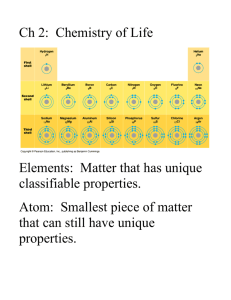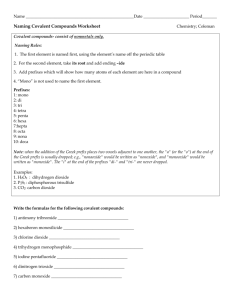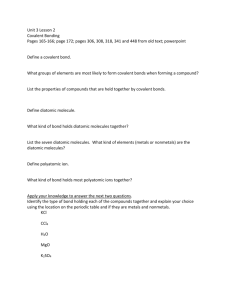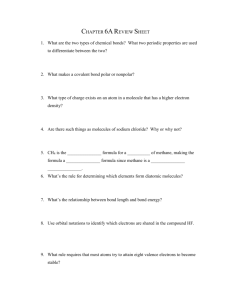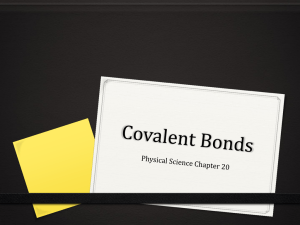Chem9CovalentBond
advertisement
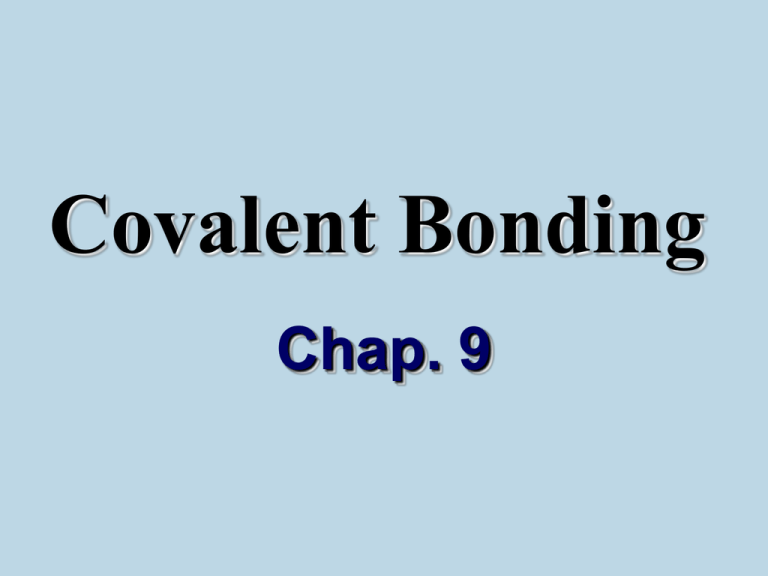
Covalent Bonding Chap. 9 I. Why does it form? I. Why does it form? A. Octet rule An atom will gain, lose, or share electrons in order to get a full set I. Why does it form? A. Octet rule B. Stability/Minimum energy I. Why does it form? II. What is a molecule? Molecule = covalent compound I. Why does it form? II. What is a molecule? A. Non-metal with a non-metal I. Why does it form? II. What is a molecule? A. Non-metal with a non-metal B. Some molecules are diatomic Molecules made of two of the same atom I. Why does it form? II. What is a molecule? A. Non-metal with a non-metal B. Some molecules are diatomic C. Properties Properties of Covalent Compounds 1. Often are gases or liquids Properties of Covalent Compounds 1. Often are gases or liquids 2. Tend to have lower M.P. Properties of Covalent Compounds 1. Often are gases or liquids 2. Tend to have lower M.P. 3. Often are soft Properties of Covalent Compounds 1. Often are gases or liquids 2. Tend to have lower M.P. 3. Often are soft 4. Many are non-electrolytes III. Representing Molecules Lewis structure uses dots and dashes to represent electrons and bonds III. Representing Molecules IV. Covalent Bond types III. Representing Molecules IV. Covalent Bond types A. Single bond Bond made of one pair of shared electrons III. Representing Molecules IV. Covalent Bond types A. Single bond B. Double bond Bond made of two pairs of shared electrons III. Representing Molecules IV. Covalent Bond types A. Single bond B. Double bond C. Triple bond Bond made of three pairs of shared electrons III. Representing Molecules IV. Covalent Bond types A. B. C. D. Single bond Double bond Triple bond Quadruple bond? III. Representing Molecules IV. Covalent Bond types V. Bond strength Bond energy measures the bond strength. III. Representing Molecules IV. Covalent Bond types V. Bond strength A. The longer the bond the ______ the bond energy III. Representing Molecules IV. Covalent Bond types V. Bond strength A. The longer the bond the ______ the bond energy B. Double bonds require _____ energy to break than single bonds. Bond energy example What is the energy change for this reaction? Is it exothermic? H2 + Cl2 H-H 436 kJ Cl-Cl 242 kJ HCl 431 kJ 2HCl VI. Naming Covalent Compounds VI. Naming Covalent Compounds A. Binary Inorganic Molecules Rules for Naming Covalent Compounds Rules for Naming Covalent Compounds 1. Name the first. . . Rules for Naming Covalent Compounds 1. Name the first. . . 2. Name the second with. . . Rules for Naming Covalent Compounds 1. Name the first. . . 2. Name the second with. . . 3. Use prefixes to tell. . . Rules for Naming Covalent Compounds 1. Name the first. . . 2. Name the second with. . . 3. Use prefixes to tell. . . 4. Never begin name with . . . Prefixes for Numbers of Atoms Prefixes for Numbers of Atoms 1. mono- Prefixes for Numbers of Atoms 1. mono2. di- Prefixes for Numbers of Atoms 1. mono2. di3. tri- Prefixes for Numbers of Atoms 1. mono2. di3. tri4. tetra- Prefixes for Numbers of Atoms 1. mono2. di3. tri4. tetra- 5. penta- Prefixes for Numbers of Atoms 1. mono2. di3. tri4. tetra- 5. penta- 6. hexa- Prefixes for Numbers of Atoms 1. mono2. di3. tri4. tetra- 5. penta- 6. hexa7. hepta- Prefixes for Numbers of Atoms 1. mono2. di- 6. hexa7. hepta- 3. tri- 8. octa- 4. tetra- 5. penta- Prefixes for Numbers of Atoms 1. mono2. di- 6. hexa7. hepta- 3. tri- 8. octa- 4. tetra- 9. nona- 5. penta- Prefixes for Numbers of Atoms 1. mono2. di- 6. hexa7. hepta- 3. tri- 8. octa- 4. tetra- 9. nona- 5. penta- 10. deca- Rules for Naming Covalent Compounds 1. Name the first. . . 2. Name the second with. . . 3. Use prefixes to tell. . . 4. Never begin name with. . . VI. Naming Covalent Compounds A. Binary Inorganic Molecules B. Common Names VI. Naming Covalent Compounds A. Binary Inorganic Molecules B. Common Names C. Organic Molecules Covalent compounds with carbon Names for organic hydrocarbons Names for organic hydrocarbons CH4 methane Names for organic hydrocarbons CH4 methane C2H6 ethane Names for organic hydrocarbons CH4 methane C2H6 ethane C3H8 propane Names for organic hydrocarbons CH4 methane C2H6 ethane C3H8 propane C4H10 butane Names for organic hydrocarbons CH4 methane C2H6 ethane C3H8 propane C4H10 butane C5H12 pentane Names for organic hydrocarbons C6H14 C7H16 C8H18 C9H20 C10H22 Names for organic hydrocarbons C6H14 hexane C7H16 C8H18 C9H20 C10H22 Names for organic hydrocarbons C6H14 hexane C7H16 heptane C8H18 C9H20 C10H22 Names for organic hydrocarbons C6H14 hexane C7H16 heptane C8H18 octane C9H20 C10H22 Names for organic hydrocarbons C6H14 hexane C7H16 heptane C8H18 octane C9H20 nonane C10H22 Names for organic hydrocarbons C6H14 hexane C7H16 heptane C8H18 octane C9H20 nonane C10H22 decane Self Check 1 Write the names for these compounds PF3 SF6 CS2 SiH4 Self Check 2 Write the formulas for these compounds Carbon tetrachloride Diphosphorus decachloride VI. Naming Covalent Compounds D. Naming acids Acids are hydrogen-donating compounds VI. Naming Covalent Compounds D. Naming acids 1. Binary Acids Acids composed of H+ ion and a monatomic anion. Rules for Naming Acids Anion Name chloride Acid Name Formula Hydrochloric acid Rules for Naming Acids Anion Name Acid Name Formula chloride Hydrochloric acid fluoride Hydrofluoric acid Rules for Naming Acids Anion Name Acid Name Formula chloride Hydrochloric acid fluoride Hydrofluoric acid bromide ?? Rules for Naming Acids Anion Name Acid Name Formula chloride Hydrochloric acid fluoride Hydrofluoric acid bromide Hydrobromic acid Rules for Naming Acids Anion Name Acid Name Formula chloride Hydrochloric acid fluoride Hydrofluoric acid bromide Hydrobromic acid ____-ide Hydro____ic acid VI. Naming Covalent Compounds D. Naming acids 1. Binary Acids 2. Oxyacids Acids composed of H+ ion and a polyatomic anion containing oxygen. Rules for Naming Oxyacids Anion Name chlorate Acid Name Chloric acid Formula Rules for Naming Oxyacids Anion Name Acid Name chlorate Chloric acid nitrate Nitric acid Formula Rules for Naming Oxyacids Anion Name Acid Name chlorate Chloric acid nitrate Nitric acid sulfate ?? Formula Rules for Naming Oxyacids Anion Name Acid Name chlorate Chloric acid nitrate Nitric acid Sulfate Sulfuric acid Formula Rules for Naming Oxyacids Anion Name Acid Name chlorate Chloric acid nitrate Nitric acid Sulfate Sulfuric acid ______ate ______ic acid Formula Rules for Naming Oxyacids Anion Name chlorite Acid Name Chlorous acid Formula Rules for Naming Oxyacids Anion Name Acid Name chlorite Chlorous acid nitrite Nitrous acid Formula Rules for Naming Oxyacids Anion Name Acid Name chlorite Chlorous acid nitrite Nitrous acid sulfite ?? Formula Rules for Naming Oxyacids Anion Name Acid Name chlorite Chlorous acid nitrite Nitrous acid sulfite Sulfurous acid Formula Rules for Naming Oxyacids Anion Name Acid Name chlorite Chlorous acid nitrite Nitrous acid sulfite Sulfurous acid ____ite ______ous acid Formula Self Check 3 Write the formulas for these compounds Carbonic acid Phosphoric acid Acetic acid VII. Structural Formulas A Lewis structure shows which atoms are bonded to which. VII. Structural Formulas A. Valence electrons important Valence electrons = outermost electrons. VII. Structural Formulas A. Valence electrons important 1. Bonding Electrons Pair of electrons shared between two elements. VII. Structural Formulas A. Valence electrons important 1. Bonding Electrons 2. Lone pairs Pair of electrons not being shared. VII. Structural Formulas A. Valence electrons important B. Drawing a Lewis structure VII. Structural Formulas A. Valence electrons important B. Drawing a Lewis structure 1. for molecules Rules for Lewis Structures 1. Determine the total . . . Rules for Lewis Structures 1. Determine the total . . . 2. Join all elements with . . . Rules for Lewis Structures 1. Determine the total . . . 2. Join all elements with . . . 3. Arrange remaining . . . VII. Structural Formulas A. Valence electrons important B. Drawing a Lewis structure 1. for molecules 2. for molecules with multiple bonds VII. Structural Formulas A. Valence electrons important B. Drawing a Lewis structure 1. for molecules 2. for molecules with multiple bonds 3. for ions Self Check 4 Draw a Lewis structure for: CH3Cl CS2 Phosphorus trifluoride Dichlorine monoxide VII. Structural Formulas A. Valence electrons important B. Drawing a Lewis structure 1. for molecules 2. for molecules with multiple bonds 3. for ions 4. resonance structures Resonance Concept that a molecule is described by more than one structure VII. Structural Formulas A. Valence electrons important B. Drawing a Lewis structure C. Exceptions VII. Structural Formulas A. Valence electrons important B. Drawing a Lewis structure C. Exceptions 1. odd number of electrons VII. Structural Formulas A. Valence electrons important B. Drawing a Lewis structure C. Exceptions 1. odd number of electrons 2. less than an octet VII. Structural Formulas A. Valence electrons important B. Drawing a Lewis structure C. Exceptions 1. odd number of electrons 2. less than an octet 3. more than an octet VIII. Molecular Shape VIII. Molecular Shape A. VSEPR Theory Valence shell electron pair repulsion theory: electrons are placed at maximum distances from other electrons VIII. Molecular Shape A. VSEPR Theory B. Molecular Shapes VIII. Molecular Shape A. VSEPR Theory B. Molecular Shapes 1. Linear (BeCl2) VIII. Molecular Shape A. VSEPR Theory B. Molecular Shapes 1. Linear (BeCl2) 2. Trigonal planar (BF3) VIII. Molecular Shape A. VSEPR Theory B. Molecular Shapes 1. Linear (BeCl2) 2. Trigonal planar (BF3) 3. Tetrahedral (CH4) VIII. Molecular Shape A. VSEPR Theory B. Molecular Shapes 1. Linear (BeCl2) 2. Trigonal planar (BF3) 3. Tetrahedral (CH4) a. trigonal pyramidal (NH3) VIII. Molecular Shape A. VSEPR Theory B. Molecular Shapes 1. Linear (BeCl2) 2. Trigonal planar (BF3) 3. Tetrahedral (CH4) a. trigonal pyramidal b. bent VIII. Molecular Shape A. VSEPR Theory B. Molecular Shapes 1. Linear (BeCl2) 2. Trigonal planar (BF3) 3. Tetrahedral (CH4) 4. Trigonal bipyramidal VIII. Molecular Shape A. VSEPR Theory B. Molecular Shapes 1. Linear (BeCl2) 2. Trigonal planar (BF3) 3. Tetrahedral (CH4) 4. Trigonal bipyramidal 5. Octahedral IX. Polarity IX. Polarity A. When is a bond polar? Polar bonds occur when electrons are shared unequally. Bond types Electronegativity Difference Bond Type Bond types Electronegativity Difference 0.0 – 0.4 Bond Type non-polar covalent Bond types Electronegativity Difference Bond Type 0.0 – 0.4 non-polar covalent 0.5 – 1.9 polar covalent Bond types Electronegativity Difference Bond Type 0.0 – 0.4 non-polar covalent 0.5 – 1.9 polar covalent 1.9 - ionic “COVALENT” Bond types 0.5 1.0 1.5 2.0 Electronegativity Difference 2.5 3.0 3.5 IX. Polarity A. When is a bond polar? B. When is a molecule polar? Polar molecules contain polar bonds and are NOT symmetrical. Self Check 5 Are the bonds in ammonia (NH3) polar? Is the molecule polar? The End

